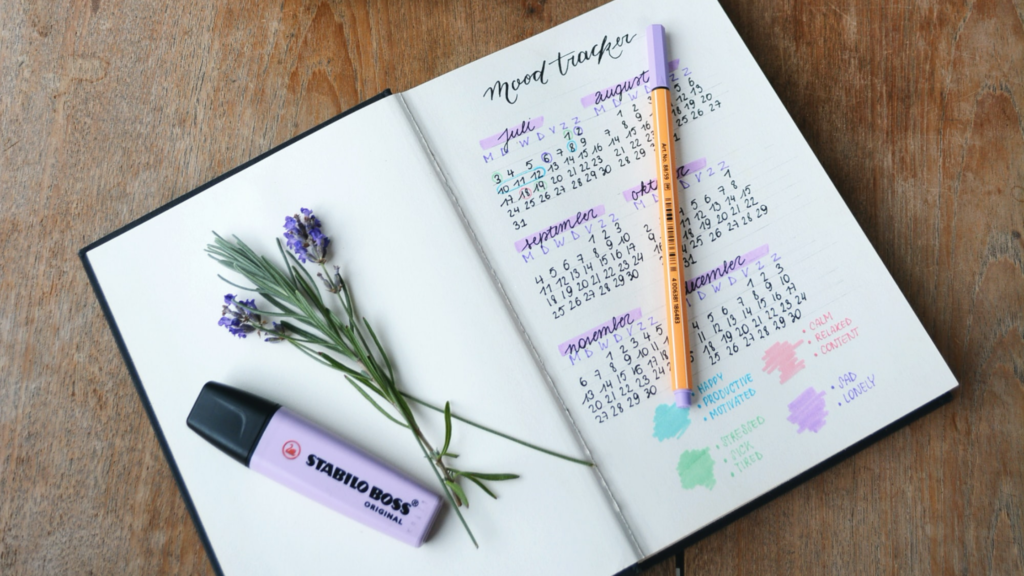I’ve been using a bullet journal since…2017? I think? And learning the basics of bullet journals introduced a simple structure to my life. So let’s talk about bujos!
Bullet Journals: More (and less) than what you see on pinterest
If you do any amount of googling about bullet journals, you’ll see pages and pages of gorgeous “spreads”. People are out there using bullet journals as sketch books, habit trackers, gorgeous hand-drawn calendars, the list goes on. But stay strong! My bullet journal has never been pretty. I don’t do cool hand lettering and the only pens I use are whatever ballpoint pen comes to hand.
Ryder Carroll developed bullet journaling in 2013, expanding to create a book and a robust website dedicated to the topic. At its core, the bullet journaling is a framework for capturing and organizing your life. Tasks, thoughts, plans, all find a spot in the bullet journal framework. It has grown to encompass a methodology for being more mindful of how you’re spending your time, but I’m going to stay surface-level about how to functionally use the system.
A note: there’s an excellent tutorial for starting a bullet journal on the website. If you want step-by-step instructions, I’d highly recommend that!
4 Concepts in Bullet Journal Basics
The framework for organizing alllll the things bouncing around in your head is comprised of four concepts: index, collections, rapid-logging, and migration.
Index
Reserve the first few pages of your notebook for the index. In the index, you’ll create a table of contents for your notebook. List what’s on a page and then the page numbers where that content is found. The reason you make an index rather than a table of contents is that, if you have multiple pages with the same kind of content, you can collapse them into one line.
The index was the game-changer for me with the bullet journal. I’ve ALWAYS kept notebooks of lists. Lists on lists on lists. But if I wanted to find something? I had to dig through it all. Now I just have to peruse my index and can flip right to the correct page!
Collections
This is a fancy word for “list” or “page”. Whatever you want to put in your notebook, lives in a collection. Getting down to basics in bullet journal, your main collections will be monthly and daily pages as well as a calendar to look forward.
My most common collections are lists of books I’ve read, notes from books or courses, and scheduling pages for when deadlines stack and get overwhelming.
Rapid Logging
This concept is what puts the “bullet” in bullet journaling. Carroll developed a series of bullet notations to help streamline the collection of information. Tasks, events, and notes all have different symbols. Organizing things this way makes it faster to scan a page and get the information you need. See this page from the bullet journal website for detailed instructions.
Migration
Migration is the act of periodically reviewing your logs and moving items forward. Traditionally, you would keep a daily log. Then, every day, you review the previous day’s log, eliminating tasks from your list that are completed or irrelevant, moving outstanding tasks to the current day’s log, and sorting events or notes to the calendar or other collection where they would stay.
Rapid logging is what makes migration possible. With the bullet notation, you can quickly scan the previous day’s log to determine how you should handle each point on the list.
Migration is the second-most valuable concept to me of the basics in my bullet journal. I have a bad habit of stubbornly holding onto tasks and goals long after I actually want or need to complete them. Somewhere in the back of my mind is a little goblin that insists I finish everything I start. When I migrate my projects from month to month, though, I’m forced to reflect on whether I really want to continue working on that particular thing.
Use Bullet Journal Basics to Make it YOURS
Like I said at the beginning, if you google “bullet journal”, you are bombarded with images of gloriously beautiful pages, hand-lettered and illustrated to perfection. But as we’ve seen, there are only four concepts that go into a bullet journal, which means that it can be whatever you want it to be.
I’m a huge fan of systems. I love to learn about them and try them out. But I sincerely believe that the best system for you is the one that WORKS for you. So if you use a digital calendar and handwriting your schedule will make you forget about meetings, don’t use that part.
For me, I stopped making daily logs when I started my personal scrum. The to do list function of bullet journaling wasn’t useful to me anymore. But I still jot things down when I need to and list it in the index.
At the end of the day, the best way to figure out if bullet journaling is for you is to try it. Don’t spend too much time reading tutorials! You’ll just get overwhelmed with other people’s creativity. Instead, try jumping in and figuring out what works for you! With these bullet journal basics under your belt, you’ll have the hang of it in no time.




No Responses